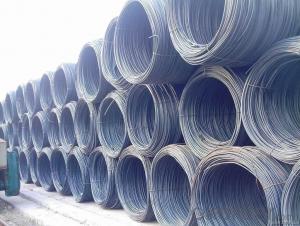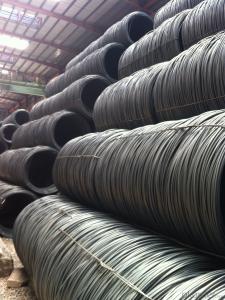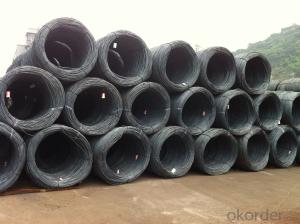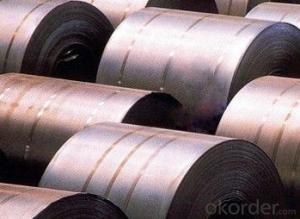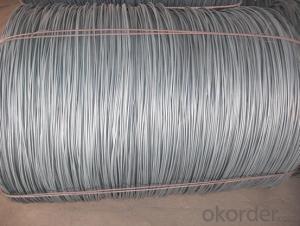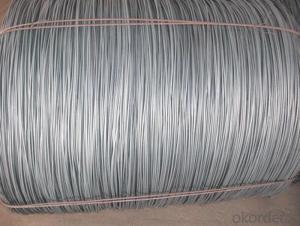Steel Wire Rods in SAE1006-SAE1018 with High Quality
- Loading Port:
- Tianjin
- Payment Terms:
- TT OR LC
- Min Order Qty:
- 25 m.t
- Supply Capability:
- 10000 m.t/month
OKorder Service Pledge
OKorder Financial Service
You Might Also Like
OKorder is offering wire rods at great prices with worldwide shipping. Our supplier is a world-class manufacturer of steel, with our products utilized the world over. OKorder annually supplies products to European, North American and Asian markets. We provide quotations within 24 hours of receiving an inquiry and guarantee competitive prices.
Product Applications:
After hot-rolled the products shaped into coil and delivery as finished product, including round, square,rectangular, hexagonal and so on. Since most of the products are round, it is generally called wire rod. Carbon steel wire rod is widely used in construction and manufacturing. Carbon steel wire rod is mainly used for reinforcement of reinforced concrete and welded structure or reprocessed (roberts , nail, etc.) materials, especially used to produce wire drawing, welding electrode, nails, spring, electronic, precise machinery parts and so on.
Product Advantages:
OKorder's Wire rods are durable, strong, and resist corrosion.
Main Product Features:
· Premium quality
· Prompt delivery & seaworthy packing (30 days after receiving deposit)
· Corrosion resistance
· Can be recycled and reused
· Mill test certification
· Professional Service
· Competitive pricing
Product Specifications:
Manufacture: Hot rolled
Grade: SAE1006-SAE1018
Certificates: ISO, SGS, BV, CIQ
Packaging: Export packing, nude packing, in coils
Grade | Chemical Composition (%) | |||||
C | Mn | S | P | Si | B | |
SAE1008B | 0.10max | 0.32max | 0.045max | 0.040max | 0.30max | 0.0008min |
Mechanical properties | ||||||
Yield strength(N/mm2) | Tensile strength(N/mm2) | Elongation (%) | ||||
≥195 | 350-380 | ≥32 | ||||
FAQ:
Q1: How soon can we receive the product after purchase?
A1: Within three days of placing an order, we will begin production. The specific shipping date is dependent upon international and government factors, but is typically 7 to 10 workdays.
Q2: How do we guarantee the quality of our products?
A2: We have established an advanced quality management system which conducts strict quality tests at every step, from raw materials to the final product. At the same time, we provide extensive follow-up service assurances as required.
Q3: The products are invoicing on theoritical weight or on actual weight?
A3: Usually, on actual weight.
Images:

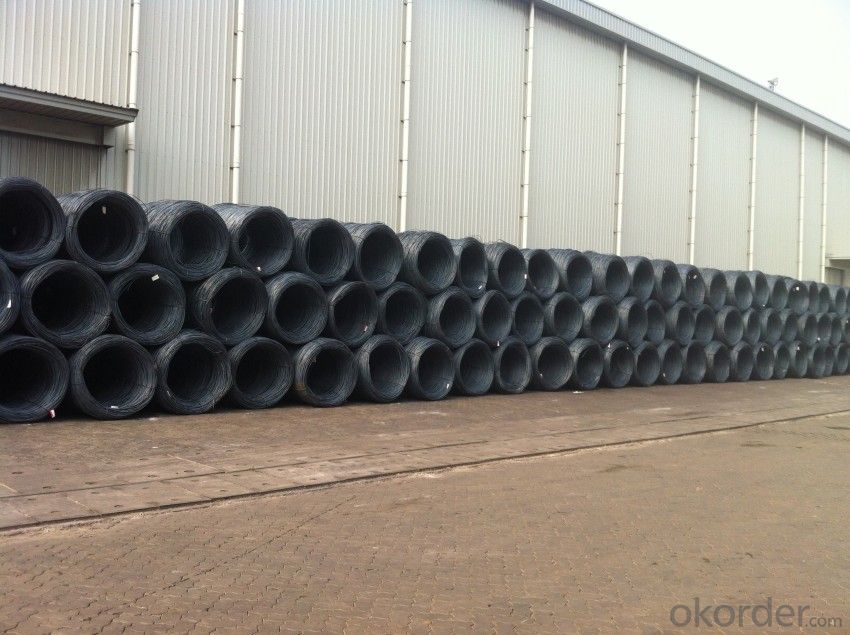
- Q:What are the different surface protection methods for steel wire rod?
- There exists a variety of surface protection methods for steel wire rods, each with different levels of protection and suitability for various applications. Some commonly used methods include: 1. Galvanization: The application of a zinc coating to the surface of the steel wire rod. Galvanization provides exceptional corrosion resistance, safeguarding the steel against moisture and chemicals. It is widely employed for outdoor or corrosive environments. 2. Coating: Steel wire rods can be coated with materials like epoxy, PVC, or polyethylene. These coatings act as a barrier between the steel surface and external factors, preventing corrosion and abrasion. They also enhance the wire's resistance to chemicals, UV radiation, and other damaging elements. 3. Phosphating: An approach that involves applying a phosphate coating to the steel wire rod. This process creates a thin layer of phosphate crystals, improving adhesion for subsequent coatings or paints. Phosphating also offers some corrosion resistance. 4. Electroplating: A method that deposits a thin layer of metal onto the steel wire rod through electrochemical means. Commonly used metals for electroplating include zinc, nickel, and chromium. This technique enhances the wire's resistance to corrosion, wear, and tarnishing. Furthermore, it adds aesthetic appeal, making it suitable for decorative purposes. 5. Powder coating: This approach entails the electrostatic application of a dry powder onto the steel wire rod, followed by curing under heat. The powder melts, forming a protective coating on the wire's surface. Powder coating provides excellent durability, resistance to corrosion, chemicals, and UV radiation. Moreover, it offers a wide range of color options and a smooth, attractive finish. Selecting the appropriate surface protection method for steel wire rods is crucial and should be based on specific requirements and the intended environment. Factors such as corrosion resistance, abrasion resistance, aesthetics, and cost-effectiveness must be considered when determining the most suitable method.
- Q:What are the common surface treatment methods for steel wire rod?
- Some common surface treatment methods for steel wire rod include galvanizing, coating with zinc or other metals to prevent corrosion; phosphating, applying a phosphate coating for enhanced adhesion of paints or lubricants; and drawing, where the wire is pulled through a die to attain desired dimensions and surface finish. Other methods may include electroplating, heat treatment, and shot blasting.
- Q:What are the different types of wire drawing processes used for steel wire rod?
- Steel wire rod can undergo several wire drawing processes to achieve different diameters and shapes. These processes include: 1. Pointing: By passing the wire rod through a series of diminishing dies, its diameter is progressively reduced. This method is suitable for smaller wires. 2. Bull block: A series of rotating cones or blocks with decreasing grooves are used to reduce the wire rod's diameter as it is pulled through. This technique is commonly employed for larger wires. 3. Continuous rotary drawing: The wire rod is fed through rotating dies, which gradually decrease its diameter. This versatile process can be used for both small and large wires. 4. Multi-pass drawing: The wire rod is drawn through multiple dies in stages, with each pass reducing its diameter. This method is ideal for very thin wires and necessitates multiple drawing stages to achieve the desired final diameter. 5. Tube drawing: Similar to wire drawing, but used to produce hollow tubes. The wire rod is pulled through a die with a mandrel inside, shaping it into a tube. This technique is commonly used to manufacture seamless steel tubes. In summary, the diverse wire drawing processes available to manufacturers offer various options for reducing steel wire rod's diameter and producing wires of different sizes and shapes to meet specific requirements.
- Q:What are the different types of steel wire rod cooling methods?
- There are several different types of steel wire rod cooling methods that are commonly used in the industry. These methods aim to efficiently cool down the wire rod after it has been processed through the hot rolling mill. The cooling methods can vary depending on the desired properties and specifications of the wire rod. One common cooling method is air cooling. In this method, the wire rod is exposed to ambient air, allowing natural convection to dissipate the heat. This is a cost-effective and energy-efficient method, however, it may not be suitable for all applications as it might not provide the desired cooling rate or uniformity. Another cooling method is water cooling, which involves spraying water onto the wire rod to rapidly cool it down. This method provides a high cooling rate, ensuring quick solidification of the steel and preventing the formation of unwanted structures. Water cooling is widely used in high-speed wire rod mills where a fast cooling rate is necessary to achieve the desired mechanical properties. Oil quenching is another cooling method used for specific applications where the wire rod needs to achieve specific hardness or strength. In this method, the wire rod is immersed in oil, such as mineral oil or polymer-based oil, to rapidly cool it down. Oil quenching allows for controlled cooling rates, resulting in the desired microstructure and mechanical properties. Some advanced cooling methods involve the use of innovative technologies such as forced air cooling or water mist cooling. Forced air cooling utilizes high-velocity air jets to rapidly cool the wire rod, while water mist cooling employs a fine mist of water droplets to achieve efficient cooling. These methods offer enhanced cooling rates and can be tailored to specific requirements. In summary, the different types of steel wire rod cooling methods include air cooling, water cooling, oil quenching, forced air cooling, and water mist cooling. Each method has its advantages and is chosen based on the desired properties and specifications of the wire rod.
- Q:What are the common applications of alloy steel wire rod?
- Due to its unique properties and characteristics, alloy steel wire rod finds a wide range of applications. Some of the common uses of alloy steel wire rod include: 1. In the automotive industry, alloy steel wire rod is extensively utilized for producing various components like springs, suspension systems, wheel rims, and engine parts. Its high strength and durability enable it to withstand demanding conditions and loads experienced by these components. 2. The construction industry also heavily relies on alloy steel wire rod. It is employed in manufacturing reinforcing bars (rebars) necessary for strengthening concrete structures such as bridges, buildings, and highways. The high tensile strength and corrosion resistance of the wire rod ensure the longevity and structural integrity of these constructions. 3. Alloy steel wire rod finds applications in various manufacturing processes like welding, machining, and fabrication. It is commonly used for producing fasteners, wire mesh, wire ropes, and springs. The exceptional properties of alloy steel, including high tensile strength, good formability, and resistance to wear and fatigue, make it an ideal choice for these manufacturing applications. 4. In the aerospace industry, alloy steel wire rod is employed for producing components and parts that require high strength, excellent fatigue resistance, and the ability to withstand extreme temperatures. This includes aircraft landing gear, engine components, and structural parts. The superior mechanical properties of alloy steel wire rod make it suitable for withstanding the demanding conditions encountered in aerospace applications. 5. The energy industry also utilizes alloy steel wire rod for various purposes. It is used in manufacturing power transmission cables, electrical conductors, and wire mesh screens. The high electrical conductivity and corrosion resistance of alloy steel wire rod make it an ideal choice for these energy-related applications. In conclusion, due to its high strength, durability, formability, and resistance to wear, corrosion, and fatigue, alloy steel wire rod is commonly used in the automotive, construction, manufacturing, aerospace, and energy industries. Its versatility and unique properties make it an essential material for a wide range of applications.
- Q:What are the different types of wire rods for reinforcement made from steel wire rod?
- There are several different types of wire rods for reinforcement that are made from steel wire rod. These include: 1. Mild Steel Wire Rods: These wire rods are made from low carbon steel and are the most commonly used type of wire rod for reinforcement. They provide good strength and durability, making them suitable for a wide range of applications. 2. High Tensile Steel Wire Rods: These wire rods are made from high carbon steel and are specifically designed to provide greater strength and resistance to tension. They are often used in applications where a higher level of reinforcement is required, such as in construction projects or in the manufacturing of heavy machinery. 3. Stainless Steel Wire Rods: These wire rods are made from stainless steel, which is a highly corrosion-resistant material. They are commonly used in environments where there is a risk of corrosion, such as in coastal areas or in chemical processing plants. 4. Galvanized Steel Wire Rods: These wire rods are coated with a layer of zinc to provide protection against corrosion. They are commonly used in outdoor applications or in areas with high levels of moisture, as the zinc coating helps to prevent rust and deterioration. 5. Copper-Clad Steel Wire Rods: These wire rods are made by cladding a layer of copper onto a steel core. They combine the strength and durability of steel with the excellent electrical conductivity of copper, making them ideal for applications where both properties are required, such as in electrical wiring or grounding systems. Overall, the different types of wire rods for reinforcement made from steel wire rod offer a variety of properties and characteristics to suit different applications and environments.
- Q:How are steel wire rods used in the manufacturing of piano strings for musical instruments?
- Steel wire rods are an essential component in the manufacturing of piano strings for musical instruments. These wire rods are typically made of high-quality steel that is carefully engineered to provide the desired properties for piano strings. The first step in utilizing steel wire rods is to draw them through a series of dies to reduce their diameter and increase their tensile strength. This process, known as wire drawing, ensures that the steel wire rods are strong enough to withstand the tension required for piano strings. Once the steel wire rods have been drawn to the desired size, they are further processed to form the individual piano strings. The wire is cut into specific lengths and then coiled to create the desired shape and size for each string. These coils are then wound around a core wire, which provides stability and enhances the tonal quality of the string. The use of steel wire rods in piano string manufacturing is crucial for several reasons. Firstly, steel is known for its durability and resistance to stretching, making it ideal for withstanding the constant tension and pressure exerted on piano strings. Additionally, steel wire rods have excellent flexibility, allowing the strings to vibrate freely and produce a rich, resonant sound. Moreover, the precise manufacturing process of steel wire rods ensures that the resulting piano strings have consistent quality and uniformity. This is crucial for maintaining the integrity and balance of sound across the entire piano keyboard. In conclusion, steel wire rods play a vital role in the manufacturing of piano strings. Their strength, flexibility, and precision make them an ideal material for producing high-quality strings that can withstand the demanding requirements of a piano.
- Q:What are the main markets for steel wire rod?
- The main markets for steel wire rod include construction, automotive, infrastructure, manufacturing, and energy sectors.
- Q:How is steel wire rod used in the manufacturing of cables and wires?
- Steel wire rod is an essential component in the manufacturing of cables and wires due to its exceptional strength and durability. It serves as the base material for the production of various types of cables and wires used in a wide range of industries. In the manufacturing process, steel wire rod is first drawn through a series of dies to reduce its diameter and increase its length. This process, known as wire drawing, helps to refine the steel wire rod and improve its mechanical properties. The wire is then subjected to various treatments such as annealing or heat treatment to further enhance its strength and flexibility. Once the steel wire rod has been properly processed, it is ready to be used in the production of cables and wires. The wire is typically coated with materials such as plastic or rubber to provide insulation and protection against moisture, chemicals, and other external factors. This coating also helps to improve the overall performance and longevity of the cables and wires. Steel wire rod is used in the manufacturing of a wide range of cables and wires, including electrical cables, communication cables, and structural cables. Electrical cables, for example, are used to transmit electricity and are commonly found in power grids, buildings, and appliances. Communication cables, on the other hand, are used for data transmission and are widely used in telecommunications and networking systems. In addition to its strength and durability, steel wire rod offers excellent conductivity, making it an ideal choice for applications that require efficient electrical or data transmission. It is also cost-effective compared to other materials, making it a popular choice for cable and wire manufacturers. Overall, steel wire rod plays a crucial role in the manufacturing of cables and wires, providing the strength, durability, and conductivity required for various applications. Its versatility and reliability make it an indispensable component in the production of high-quality cables and wires used in various industries.
- Q:How is steel wire rod stored and handled to prevent damage?
- Steel wire rod is typically stored and handled with great care to prevent any damage that could compromise its quality and performance. To ensure the integrity of the wire rod, several measures are typically taken. Firstly, steel wire rod is stored in a designated area that is clean, dry, and well-ventilated. This minimizes the risk of exposure to moisture, which can lead to corrosion and rusting. Additionally, the storage area should be away from any potential sources of damage such as heavy machinery, sharp objects, or chemicals that could cause surface abrasions or chemical reactions. To prevent any physical damage, steel wire rod is often stacked on pallets or racks to keep them off the ground and protect them from any potential impact or contamination. The stacking height should be limited to avoid excessive pressure on the lower layers, which could result in deformation or breakage. Furthermore, steel wire rod is typically bundled or coiled to provide additional protection during storage and transportation. Bundling helps to maintain the shape and integrity of the wire rod, preventing any bending or warping. Coiling, on the other hand, is commonly used for longer lengths of wire rod and provides better handling and storage options. During handling, personnel should be trained in safe lifting and transportation techniques to prevent any mishaps that could damage the wire rod. The use of appropriate lifting equipment, such as cranes or forklifts, is recommended to minimize the risk of dropping or mishandling the wire rod. Regular inspections should also be conducted to identify and address any signs of damage or deterioration, such as surface rust, dents, or deformations. Any damaged wire rod should be promptly removed from storage and replaced to prevent further deterioration or potential safety hazards. By following these storage and handling practices, steel wire rod can be effectively protected from damage, ensuring its quality and performance are maintained throughout its lifespan.
1. Manufacturer Overview |
|
|---|---|
| Location | |
| Year Established | |
| Annual Output Value | |
| Main Markets | |
| Company Certifications | |
2. Manufacturer Certificates |
|
|---|---|
| a) Certification Name | |
| Range | |
| Reference | |
| Validity Period | |
3. Manufacturer Capability |
|
|---|---|
| a)Trade Capacity | |
| Nearest Port | |
| Export Percentage | |
| No.of Employees in Trade Department | |
| Language Spoken: | |
| b)Factory Information | |
| Factory Size: | |
| No. of Production Lines | |
| Contract Manufacturing | |
| Product Price Range | |
Send your message to us
Steel Wire Rods in SAE1006-SAE1018 with High Quality
- Loading Port:
- Tianjin
- Payment Terms:
- TT OR LC
- Min Order Qty:
- 25 m.t
- Supply Capability:
- 10000 m.t/month
OKorder Service Pledge
OKorder Financial Service
Similar products
New products
Hot products
Hot Searches
Related keywords
